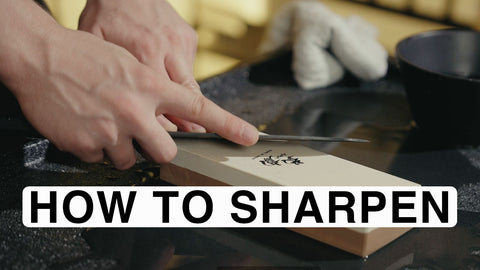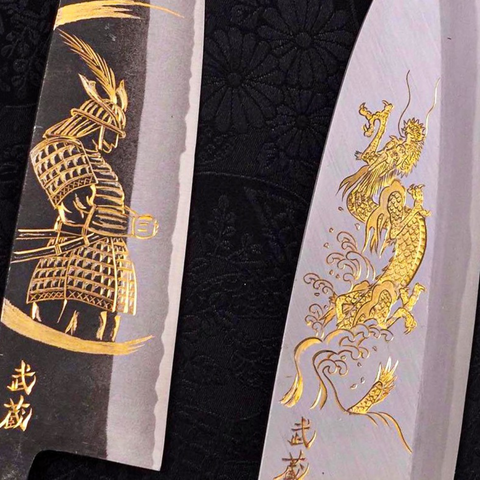Forging a Greener Future: Sustainable Knife Production

At Musashi Japan, we’re not only committed to preserving the art of traditional Japanese knife-making but also to protecting the planet from which this craft originated.
1/ A Timeless Craft That Has Remained Sharp Through the Ages
Although traditional Japanese knife-making is a centuries-old craft, it has continued to stand the test of time. Even today, Japanese knives are regarded as some of the most reliable tools for kitchen work. What’s more, the craftsmen still use techniques that have been passed down through generations, nearly unchanged from those developed centuries ago.

While modern alloys are available, Japanese chefs often prefer carbon-steel knives, known for enhancing umami and holding their edge far longer than stainless alternatives. The secret lies in Japan’s unique approach to steel: Japanese blades typically contain higher carbon levels—often 1% or more—making them harder, easier to sharpen, and better at retaining a sharp edge.
![Santoku Stainless Clad Blue Super Polished Shitan Handle 170mm-Blue Super-Polished-Japanese Handle-[Musashi]-[Japanese-Kitchen-Knives]](https://cdn.shopify.com/s/files/1/0449/9433/0781/files/Santoku-Stainless-Clad-Blue-Super-Polished-Shitan-Handle-170mm-Blue-Super-Polished-Japanese-Handle-Musashi-Japanese-Kitchen-Knives-8_480x480.jpg?v=1730689407)
For example, this Santoku is made of one of the greatest Japanese Carbon Steels. It has excellent edge sharpness and excellent edge retention but is also capable of attaining high hardness without being brittle.
And it's not just the material that sets these knives apart; the mastery involved in their creation makes them exceptional. Japanese bladesmiths dedicate years to honing their skills, crafting each blade with precision and care.
By collaborating with individual bladesmiths from various prefectures, we showcase the diversity and depth of traditional Japanese knifemaking, ensuring that each region's unique techniques and styles continue to shine.
2/ Not Just a Tool, A Lifelong Kitchen Companion
In Japanese culture, tools are respected as extensions of the craftsperson's heart and soul. This bond reflects a deep cultural value, where items are chosen not merely for functionality but as companions in one’s work. This connection fosters a greater appreciation for tools made with care and skill, rather than those mass-produced in factories.
Guided by a minimalist philosophy, many Japanese chefs rely on a few selected knives for decades, choosing only what they truly need to perfect their craft. They honor the skill of the knife maker by meticulously caring for their tools, ensuring they remain sharp and free from rust over time.

Another aspect of traditional Japanese knives that makes them more sustainable than mass-produced ones lies in the material used. As we saw earlier, Japanese blade makers select harder material for their knives. This hardness allows for cleaner cuts, which preserve the ingredients' freshness, flavor, and texture by reducing oxidation, a factor that can be intensified by dull knives.
In essence, our traditional Japanese knives embody the philosophy of Mottainai—using tools to their fullest potential and extending their longevity through careful, intentional use.
3/ Merging Traditions and Innovations: Creating a Knife Made from Marine Debris
Since Japanese knives are crafted to last for decades, we share a deep concern for the future of our planet, just as the skilled artisans we work with do.
In which conditions will our traditional knives be used in the future? And what value does a beautifully crafted kitchen knife hold if the quality of the food it prepares is compromised by global plastic pollution?
As a brand committed to sustainable product development and supporting Japan’s environmental initiatives, we sought ways to leverage our expertise to create meaningful impact—and found our answer on Tsushima Island.

Tsushima Island, famously known as the setting of the game Ghost of Tsushima, is also a global hotspot for marine plastic pollution. The island’s beaches receive massive amounts of ocean-borne plastic waste, which is a significant environmental challenge. Despite Tsushima City investing around 280 million yen annually to collect and manage this debris, only about 8,000 cubic meters are recovered from the 20,000 to 30,000 cubic meters that wash ashore each year.

But what to do with all this plastic? Simply collecting and recycling isn’t enough to tackle the problem. We decided to take a more innovative approach: creating enduring, non-discardable products from discarded plastics.
Our solution? To repurpose ocean plastic waste into beautiful and functional items.
Here is a few selections from our ocean knives collection:
1. Bunka AUS-10 Nashiji Damascus Mirror
2. Santoku White Steel #1 Stainless Clad Tsuchime
3. Gyuto AUS-10 Wave Nickel Damascus
We are the first brand to design a knife with SDG goals in mind, and after a year of development, our first Tsushima Ocean Knife was born. Now, in its second generation, each Ocean Plastic handle features an embedded NFC chip. With a simple tap of your phone, this chip links to our website, where you can learn more about your knife’s story and our recycled plastic initiative.

These knives are crafted for daily use, designed not only for kitchen tasks but to spark conversations about sustainability. Whether at home gatherings or other events, they serve as reminders of the importance of the Sustainable Development Goals (SDGs) and the small actions we can take to protect our planet.
We recognize that our approach is just a small step forward and we will continue to do more in the future to stay at the forefront of sustainable knife production.
4/ A Lifetime Knife Aftercare Service
We stand behind the quality of our knives, which is why we offer a lifetime of free knife repair and sharpening services to all of our customers. You only need to cover the cost of round-trip shipping.
Once we receive your knife, our team of experts will thoroughly inspect it, carefully smooth out any scratches, and sharpen it to restore its original precision and performance.

If you ever have questions about caring for or using your knife, visit our website or YouTube channel for helpful guides and tutorials. At Musashi, we're dedicated to ensuring you get the most out of your knife, which is why we regularly update our site with new videos and articles.
Stay up to date by creating your Musashi Japan account today!

![Musashi Japanese Style Kitchen Knife Roll Black Koi 1 Pocket Handmade-[Musashi]-[Japanese-Kitchen-Knives]](http://www.musashihamono.com/cdn/shop/products/Musashi-Japanese-Style-Kitchen-Knife-Roll-Black-Koi-1-Pocket-Handmade-Musashi-Japanese-Kitchen-Knives.jpg?crop=center&height=140&v=1734154913&width=140)


